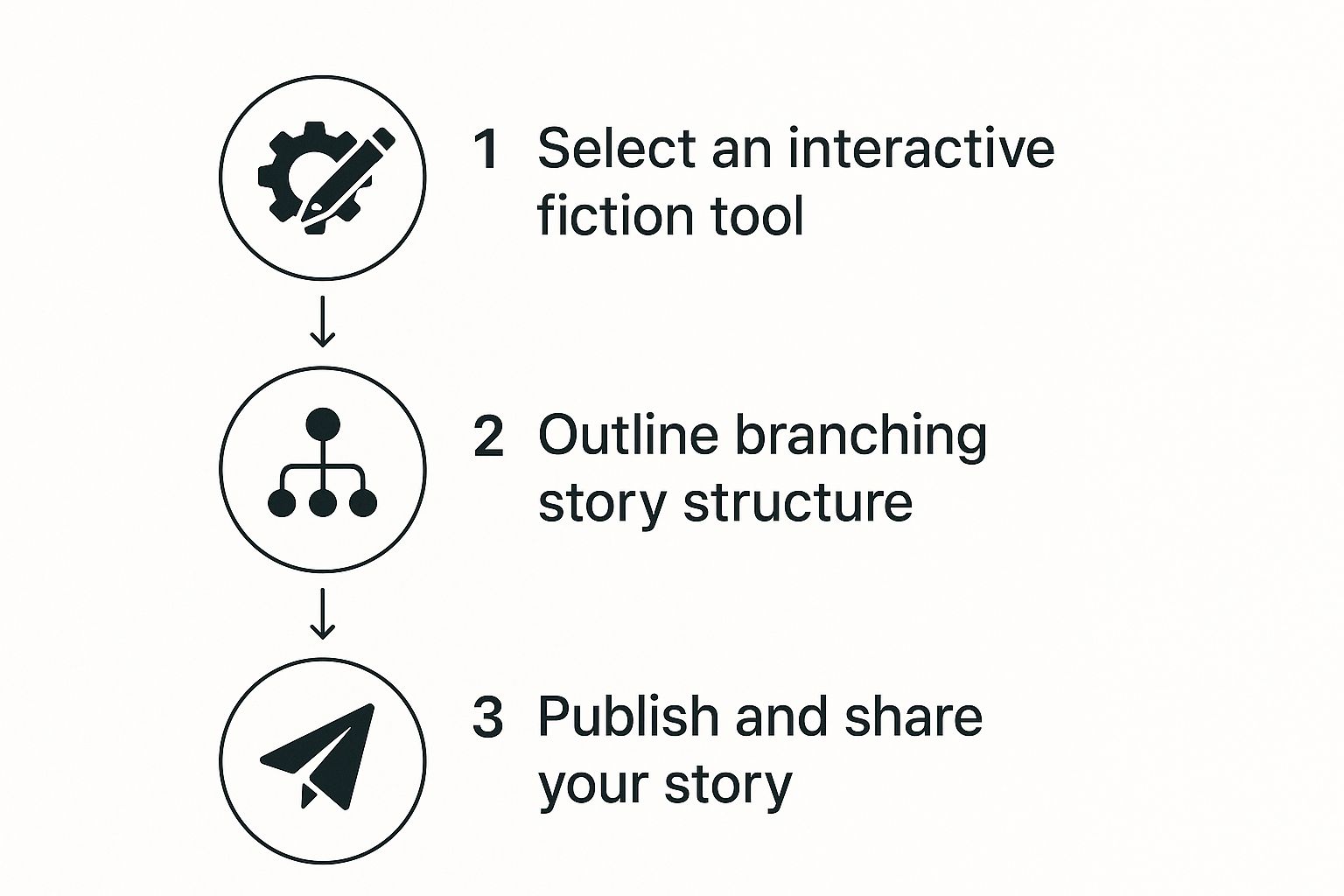Create Your Own AI Girlfriend 😈
Chat with AI Luvr's today or make your own! Receive images, audio messages, and much more! 🔥
4.5 stars

Diving into interactive fiction means you're not just a storyteller; you're an architect of experiences. The real art is in blending a captivating narrative with choices that truly matter to the reader. It's a dance between a compelling plot and the freedom you give the player to lead the way.
Laying the Groundwork for Your Interactive Story

Before you even think about writing the first scene, it’s crucial to understand what makes interactive fiction tick. It's fundamentally different from a linear novel. The secret sauce is player agency—that powerful feeling a reader gets when they know their decisions genuinely steer the story and shape the world around them. This is where you have to start.
A traditional story moves neatly from point A to point B. Yours, on the other hand, will be a web of interconnected possibilities. Every choice the player makes needs to feel like it has weight. That doesn't mean every single decision has to unlock a brand-new ending, but it should at least color the journey in a noticeable way.
This shift toward immersive formats is more than a niche trend. The global fiction book market, valued at around $11.16 billion one year and projected to hit $11.38 billion the next, is seeing growth partly driven by these new ways of telling stories.
The Essential Components
To build a truly compelling interactive story, you'll need a solid grasp of its core elements. Think of these as the foundation upon which you'll build your entire narrative world.
Here's a quick breakdown of what makes these stories work:
Core Elements of Interactive Fiction
| Element | Description | Key Goal |
|---|---|---|
| Branching Narrative | A story structure with multiple paths determined by player choices. | Create a sense of consequence and replayability. |
| Player Agency | The player's ability to make meaningful decisions that impact the story. | Make the player feel like a co-author of the experience. |
| Dynamic World | A setting that reacts and changes based on the player's actions. | Foster deep immersion and a believable environment. |
| Responsive Characters | Non-player characters (NPCs) who remember past interactions and react accordingly. | Build authentic relationships and emotional investment. |
Nailing these elements is what separates a simple "choose your path" story from a truly unforgettable interactive experience.
Bringing Your World to Life
Your story needs a central conflict, a driving force that naturally invites interaction and tough decisions. The best conflicts present players with dilemmas that have no simple, black-and-white answers, forcing them to forge their own path based on their values.
The real challenge in writing interactive fiction isn't just generating more text. It's managing the massive complexity that explodes with every new choice. Each branch means more to write, more to test, and more to weave into a coherent whole.
This is where planning becomes your best friend, and modern tools can be a lifesaver. Brainstorming worlds, characters, and plot twists from scratch can feel overwhelming. AI scenario generators are fantastic for breaking through creative blocks and helping you flesh out those initial ideas.
If you're looking for a starting point, you can create AI-driven scenarios to get the ball rolling. Thinking through these foundational pieces from the get-go is what will transform a cool concept into a rich, immersive world your readers won't want to leave.
How to Architect Your Interactive Narrative
A great interactive story is designed, not just written. Before you even think about crafting prose and dialogue, you need a solid architectural plan. I've seen too many exciting ideas get derailed by plot holes and overwhelming complexity simply because the creator skipped this step. This planning phase is your best defense against that creative chaos.
Think of yourself as an architect drawing up a blueprint. Your first job is to lock down the story's core premise and its major plot points—these are the unshakeable pillars of your narrative. What's the central conflict? What key events absolutely must happen to push the story forward?
Once you have those pillars in place, you can get to the fun part: brainstorming multiple, satisfying endings. A story with only one "true" ending and a bunch of "bad" ones can feel cheap and punishing. Instead, try to create a variety of conclusions that feel like natural, earned outcomes of the player's journey. Each one should offer its own sense of closure. This is what brings players back to explore again and again.
This workflow chart gives you a good visual overview of the whole process, from that initial spark of an idea to a published piece.

As you can see, a successful project is all about balancing the tools you use with a strong focus on outlining your narrative structure before you start writing for real or think about publishing.
Mapping Your Branching Paths
With your main plot points and potential endings figured out, it's time to pinpoint the crucial decision points. These are the moments where a player's choice will genuinely alter the story's path. Not every choice needs to be a world-shattering event, but they should all create ripples.
Visual tools are your best friend here. You don't need fancy software; a simple flowchart or a mind map on a whiteboard can work wonders.
- Flowcharts: These are excellent for visualizing a story that progresses with clear branches. Each box is a scene or event, and the arrows show exactly how choices connect them.
- Mind Maps: I find these are perfect for more exploratory, non-linear stories. Just put your core concept in the center and let ideas, characters, and plot threads branch out from there.
This visual approach helps you see the entire narrative landscape at a glance. It makes it so much easier to spot continuity errors or branches that lead to nowhere.
The real challenge in creating interactive fiction is managing what experts call the "authorial burden." Every new choice you add creates an exponential amount of extra writing, testing, and structural work. A solid plan is the only way to keep that from spiraling out of control.
Structuring for Player Engagement
As you map your story, think about the rhythm of your choices. Players want to feel involved, and that means interacting frequently. A good rule of thumb is to present a choice within the first few hundred words and then maintain that pace throughout each branch of the story.
This is where you can tap into the growing interest in this medium. While still a niche, the interactive fiction market was recently valued at around $150 million. That's a clear signal that there's a real appetite for stories where readers influence the outcome. If you're curious, you can read more about the interactive fiction market trends to get a sense of its growth.
By architecting your narrative with a clear structure from the start, you're doing more than just organizing your thoughts. You're building a coherent and engaging experience for your player, no matter which route they take. This upfront work is what separates a polished, professional story from a confusing mess.
Crafting Choices That Truly Matter
 Meaningful choices are the absolute heart of interactive fiction. They’re what turns a simple story into a deeply personal and unforgettable experience. But what makes one choice compelling and another one fall flat? It all comes down to consequence.
Meaningful choices are the absolute heart of interactive fiction. They’re what turns a simple story into a deeply personal and unforgettable experience. But what makes one choice compelling and another one fall flat? It all comes down to consequence.
Your real goal is to make the reader feel like they're a co-author of the adventure, not just a bystander turning pages. This means crafting decisions that present real dilemmas—the kind that make someone pause, think, and truly weigh their options. When you create interactive fiction, every single choice point is a chance to pull your reader deeper into the world.
The Spectrum of Player Choice
Not every choice needs to be a world-ending, life-or-death decision. In fact, the best interactive stories are a careful blend of different kinds of choices. This mix is what makes the narrative feel dynamic and responsive. I like to think of them as being on a spectrum.
Flavor Choices: These are the small things that add personality without derailing the main plot. Think about letting a player deliver a line sarcastically versus politely. The outcome might be the same, but the tone of the scene changes, making the character feel more like their own.
Strategic Choices: These choices have tangible, short-term consequences. Maybe you have to choose between packing a medkit or a lockpick for a mission. The medkit might save an ally down the line, but the lockpick could have opened a door to hidden loot. These decisions reward a little bit of foresight.
Branching Choices: These are the big ones. The decisions that send your story careening down a completely new path. Deciding to betray a key ally or save a sworn enemy can unlock entirely different scenes, character arcs, and endings.
A truly masterful story weaves all three of these together. A few small flavor choices establish a character's personality, which then gives a major branching choice much more emotional weight. It's this variety that breathes life into the world you're building.
State Tracking and Lasting Consequences
So, how do you give choices that feeling of lasting impact? The secret ingredient is state tracking. It’s just a technical term for the story remembering what the player has done. When your story remembers that a player was kind to a beggar in Chapter 1, that same beggar might pop up later with a crucial hint.
The most powerful choices are those that ripple through the story. A single decision made in the first chapter should have the potential to come back and influence events in the final act, for better or for worse. This creates a deeply satisfying sense of cause and effect.
Let’s look at a classic example: the player can either lie to a guard or tell the truth.
- Lie: You might get through the gate easily right now. But later, that guard could discover your lie and put the entire city on alert, making your life much harder.
- Tell the truth: You're denied entry, but you earn the guard's respect. Later on, that same guard might be the one to vouch for you when you're in a tight spot.
This is what we mean by choices that matter. They aren’t just isolated moments; they're interconnected threads in a larger, responsive tapestry.
Modern tools are a huge help here. For example, the character and scenario tools available on Luvr AI are great for brainstorming these kinds of interconnected plot points and keeping everything straight. By tracking simple variables like "Guard_Trust" or "Player_Honesty," you can build a story that genuinely adapts to every decision, making each playthrough a truly unique journey.
Writing Immersive Dialogue and Descriptions

In interactive fiction, your words do all the heavy lifting. They build the world, drive the action, and give your characters their soul. If you want to create interactive fiction that really sticks with a player, you have to write prose that pulls them in without ever slowing them down.
It all comes down to finding the right balance. A long, beautiful paragraph of description might be perfect for a novel, but in an interactive story, it can grind the momentum to a halt. The player is here to do something. Your job is to set the scene and get them to a choice, ideally within the first few hundred words of a new scene.
Focus on sharp, sensory details. Think the smell of ozone after a lightning strike or the low hum of a city at night. These small touches paint a vivid picture much faster than a wall of text ever could.
Crafting Dialogue That Reacts
This is what truly separates a decent story from an unforgettable one. Conversations shouldn't feel like a pre-written script the player is just clicking through. They need to be dynamic exchanges that shift and change based on the player’s choices. If the player lied to someone earlier, that character should now sound a little more suspicious.
This is where the real work—and the real magic—begins. Here are a few techniques I always rely on to make conversations feel alive:
- Conditional Lines: A character might say, "It's you again," but only if the player has actually met them before. It’s a tiny detail that makes the world feel consistent and real.
- Reflecting Player Tone: When you give a player a choice like [Shout back] or [Stay silent], the next beat of dialogue absolutely must honor that emotional choice.
- Recalling Past Actions: Nothing makes a player feel more seen than a character referencing something they did. A simple, "That was a neat trick with the security bot," makes their past decisions feel meaningful.
The best dialogue isn't just about what's being said in the moment. It's about what’s being remembered. When characters react to the player's history, the story stops being a linear path and starts feeling like a personal journey.
Using AI as a Creative Partner
We've all been there. Staring at a blank page, trying to come up with five different ways a character could react to the same piece of news. It's tough, especially with branching narratives. This is where AI tools can be an incredible creative sidekick. They aren’t here to write the story for you, but to help you explore its possibilities.
For example, if a character discovers a betrayal, you can use a scenario generator to quickly brainstorm reactions. You might ask for three versions: one explosive and angry, one quietly devastated, and one cold and calculating.
Look at this setup in Luvr AI. You can feed it a character's core personality, their history, and their quirks.

When you give the AI this kind of detailed context, the dialogue or descriptions it suggests will be far more aligned with the character you've built in your head. You can then take these starting points, polish them with your own voice, and drop them right into your story. It's a fantastic way to break through writer's block and keep your story's many threads consistent.
A Practical Guide to Testing and Refining
Let's be honest: your first draft won't be perfect. No great interactive story ever is. The real magic happens after the writing stops and the testing begins. This is where you polish your rough diamond into something that truly shines for your players.
Think of it as a cycle: play, find the flaws, revise, and repeat. It’s a non-negotiable part of the process.
Your first job is to become your own harshest critic. Put on your player hat and methodically go down every single path you've created. The goal here is simple: break your own story. Make every choice, good and bad, to find any branch that leads to a dead end, a weird bug, or an ending that just feels abrupt and unsatisfying.
This is also your chance to catch those sneaky continuity errors. Did a character who died two scenes ago suddenly pop up to offer advice? Does the player's inventory list an item they never picked up? These little details can completely pull a player out of the world you’ve worked so hard to build.
Gathering Actionable Feedback
After you’ve done your own sweep, it’s time for a fresh perspective. You're too close to your work to see all its quirks and flaws. This is where beta readers come in—they are worth their weight in gold. They'll spot the plot holes and confusing choices you've gone blind to.
But you have to guide their feedback. Just asking, "So, what did you think?" is a waste of everyone's time. You need to ask sharp, targeted questions to get feedback you can actually use.
Try asking things like:
- Which decision gave you the most pause? What made it so tough?
- Was there a moment when you felt stuck or had no idea what to do?
- Did any character react in a way that felt completely wrong or unbelievable?
- Which storyline felt less exciting or developed compared to the others?
The most insightful feedback often comes from moments of player frustration. When a reader says, "I thought choosing X would do Y, but it didn't," that's a golden opportunity to either clarify the choice's framing or adjust its outcome to better meet player expectations.
This feedback loop is what separates good stories from great ones. And there's a growing demand for great ones. The market for interactive books, which is exactly where the stories you create interactive fiction for live, was recently valued at $2.5 billion. Experts see it growing by about 8% annually, proving that players are hungry for well-crafted, engaging experiences. You can discover more insights about the interactive book market growth and see where things are headed.
Thorough testing isn't just a step in the process; it's your key to creating a story that meets—and exceeds—that growing demand.
Got Questions About Making Interactive Fiction? We've Got Answers
Stepping into the world of interactive fiction for the first time, you're bound to have questions. It’s completely normal. Think of this as your friendly FAQ, tackling the common hurdles that trip up new creators. Getting these cleared up will help you build your story with confidence.
What Are the Best Tools for a Beginner?
When you're just starting, you don't want to fight with your tools. You want something that lets you focus on the story. That's why I almost always recommend Twine to newcomers. It uses a visual, flowchart-style map that lets you see your story's branches laid out right in front of you—no coding required. It’s a lifesaver for keeping track of complex narratives.
Another great starting point is Inform 7. It’s a bit different, using a natural-language syntax that feels more like writing instructions in plain English than coding. And of course, tools like Luvr AI can be a massive help for getting past that initial blank page by generating character concepts, scene ideas, and even dialogue to get your creative juices flowing.
How Can I Make Player Choices Actually Matter?
This is the big one. The secret to meaningful choices is simple: consequences. A choice only feels important if the player sees a tangible result, big or small. Maybe a different line of dialogue appears, a character's attitude shifts, or a completely new story path unlocks.
What you absolutely must avoid are "false choices"—options that all funnel into the exact same immediate outcome. That's the fastest way to break a player's immersion. The best choices tie back to your story's core themes, forcing the player to make a tough call. That’s where the emotional punch comes from.
How Long Should My Interactive Story Be?
There’s no magic number here; it really depends on the story you want to tell. A compact, focused story might run between 5,000 and 10,000 words across all its branches. On the other hand, an epic, novel-sized adventure could easily soar past 100,000 words.
Instead of total word count, a better metric is playthrough time. A 20-30 minute playthrough is a fantastic sweet spot. It feels substantial, but it’s also short enough to tempt players to jump right back in and see what they missed. Replayability is your best friend.
Is It Possible to Make Money With This?
Yes, absolutely! Several paths are open to you. The most direct route is selling your finished games on marketplaces like Steam or itch.io. Many authors also find success on dedicated interactive fiction apps, often using a "freemium" model where readers can pay to unlock special choices or chapters.
Another popular and effective model is building a dedicated following through a platform like Patreon. This allows your biggest fans to support you directly in exchange for behind-the-scenes content or early access.
For more in-depth guides on storytelling and character creation, check out the other articles on the Luvr AI blog.
Ready to bring your own characters and scenarios to life? With Luvr AI, you can design unique personalities, craft intricate backstories, and generate immersive dialogue to build the interactive stories you’ve always imagined. Start creating today at https://www.luvr.ai.



